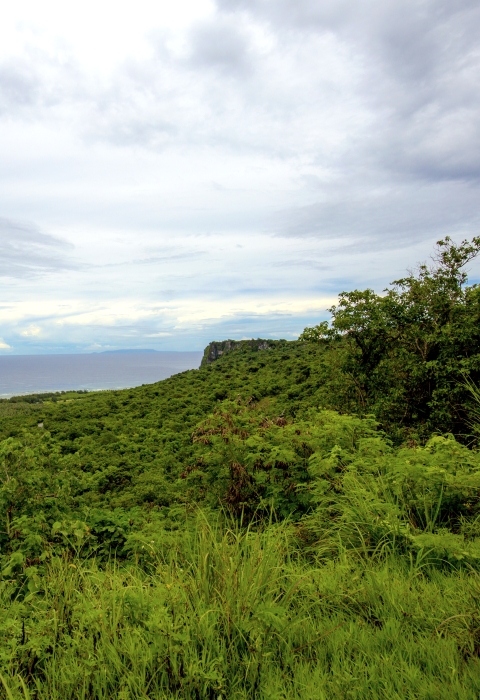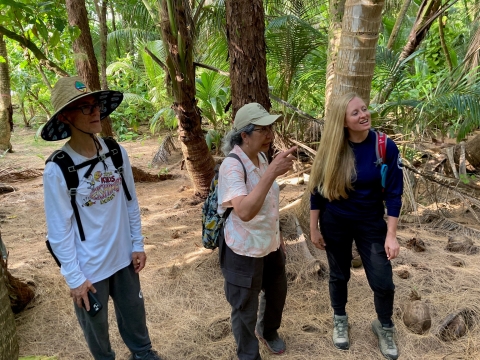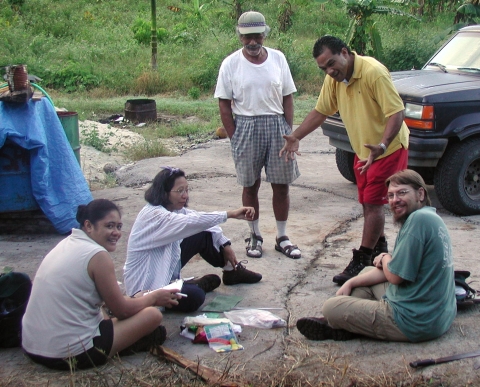Ruth Utzurrum has always been inquisitive.
From spider fights to flying foxes, Utzurrum followed her curiosity to a job as a wildlife biologist with the U.S. Fish and Wildlife Service’s Office of Conservation Investment (formerly known as the Wildlife and Sportfish Restoration program). Utzurrum facilitates grants and partnerships in the Pacific Islands and territories, including Hawaii, Guam, and the Commonwealth of the Northern Mariana Islands. Her childhood in the Philippines shaped her approach toward conservation and partnerships, which is driven by respect for people and habitat, finding joy every day, and practicing the “art of the possible.”
Below is an interview with Utzurrum.
Tell us about yourself. How did you become interested in conservation or the work that you do? (Any mentors or conservation heroes?)
I am from the Philippines, from a fishing-farming town on the southwestern tip of Luzon Island, which is my mother’s hometown. I only came to the U.S. to pursue graduate studies. By then, I already had a master’s degree in biology and had been teaching at a university for almost 10 years. Those years shaped who I am.
Our family resided in town, but I was into digging up worm baits and fishing streamside with a simple fishhook tied to a nylon string to a bamboo stick. I was inquisitive: I played with ants, “What would they do if I trapped them in a hole covered with a glass shard?”, and antlions, “Why does it move backwards?” My friends and I would also collect spiders and have “spider fights.” We would come together with spiders in an empty match box, put one spider on each of a slender stick, and see what happened. Most often, it was nothing – we did not have the patience to wait for action.
It was very much a mixed economic strata neighborhood, but at end of a day and on weekends, kids would pour into the street, and we all played together mostly until dusk until we were all called back home. The story was, we should not be caught outside once the geckos come down and kiss the ground and make their calls. On the streets, playing games evened the field.
Both of my parents were educators. Back then it was widely viewed that a tertiary school degree was the yellow brick road to a good and stable job. So many parents made extreme sacrifices so their children could attain a degree. I ended up at Silliman University on Negros Island, a small but renowned private university (total student population then was about 5,000 from prep to grad school), and there started a career journey of adventures. I completed a five-year Bachelor of Science degree in medical technology and was offered and accepted a teaching job in the biology department.
What did you study or how did you get involved in public service? How did you find your way to the Service?
Between the time spent digging earthworms and finishing college, I did not really expect to end up in biology or conservation. Because my bachelor’s degree was in medical technology, I may have been working in a hospital if not for a lengthy delay in release of results in the national licensure exam the year I took it.
Silliman University was, and still is, very active in the conservation movement in the Philippines. There were minimal funds for conservation work then. We were ecstatic to receive funds that would allow us to gas up a vehicle so we could go do some field work; we got good at improvising.
Once, we needed to estimate water volume of a small lake that the local utility company wanted to develop for hydroelectricity. We thought it was ill-conceived, but there was a foreign aid grant for it. The company knew there was opposition, so they chose not to share information about the project. At least if we could estimate water surface area and some depth measurements, we could arrive at a rough estimate of lake volume. We did not have mapping tools or funds to hire surveyors. Engineering students who initially volunteered to help backed out; it was a long hike and involved several river crossings with quite a bit of current. So, we procured some spools of rope, and marked measured segments and compasses. With the help of some willing volunteers, we measured distance and triangulated between points across the lake, in inclement weather at that. We had our map (hand drawn with pencil, ruler and protractor on a graphing paper), our lake surface estimate and loads of laughter and good memories.
There was excitement in the budding conservation movement at the university – pioneering establishment of community-based marine protected areas and multi-disciplinary analysis of conservation impacts to small upland subsistence communities. Through all the field projects I was involved with, I quickly saw that in the spectrum of seemingly opposing goals of conservation and development, what is lost or hidden are the local communities who simply want to do better for themselves and their families. They are the ones left to balance the expectations (and often demands) of conservation and development.
Wildlife work in American Samoa took us to other places in the southwestern Pacific for sampling for a population genetics study on the two species of flying fox (bats) in the territory, and for a geographic survey of blood parasites of birds. We formed partnerships with counterpart agencies and had local staff work with us. Our work in western Samoa led to a memorandum of understanding between our respective resource agencies for technical assistance and collaboration. That is one accomplishment I am quite proud of.
Work then and now gave me the opportunity to see places not in travel magazines, see and hold creatures in my hand that not even many locals have, but most importantly meet people from varied walks of life and cultures; for these, I am forever grateful and appreciative. I learned that we are each unique but not set apart and respect is paramount in all aspects of work and life; this I hope to continue to have as my guidepost.
What do you do in your job at the Service?
My official job title is wildlife biologist (grants), but what I do is review grant applications for eligibility, robustness of proposed work, and that funds requested are reasonable (not under budget, not overbudget) in what the regulations term as “substantial in character and design.” I also provide technical assistance leading up to applications to help our grant partners meet these standards. After grants are awarded, I provide guidance for their implementation and in meeting deliverables within timelines, and conduct site visits and talk to partners about challenges to implementation.
I am very fortunate to work with partners in the Northern Mariana Islands and Guam. I get to see projects on the ground more closely, and I feed off the interactions with project biologists and occasionally their own external collaborators in the planning stages of projects. My work is complex and challenging, and there’s always something unexpected – you may have to think fast on your feet. Because in the end, conservation is about people.
What's your favorite thing about working for the Service?
The not-so-secret sauce is the team environment. I am fortunate to be with a very supportive, collaborative, and fun team. Even with the transition to a less traditional work environment (with remote and lots of telework) and turnover in our group, the camaraderie and cohesiveness remains strong. I believe it shows what we are able to achieve.
In the broader Service community, there is that sense of purpose and support among programs. We each have our own direct missions, yet that diversity leads us to one place: conservation in a connected world. My personal sense is that cross-program opportunities and collaborations have really blossomed in recent years. I hope that can be sustained at the very least through future years. It is invigorating.
What is one of your favorite projects or memories from the Office of Conservation Investment?
Many of us who have been around collecting data are familiar with stacks of survey paper and waterproof notebooks filed away in filing cabinets. Long-term monitoring of birds and mammals in the U.S. Pacific territories funded with the Service’s Wildlife Restoration dollars have a long history, some dating back to 1980s. After a couple of years interacting with partners in the Northern Mariana Islands on their annual proposals, I started prodding their biologists about how the data were used and how it could be organized for future use.
Their paper files have been scanned and digitized, most data collection are now done on field tablets to sync with office servers for automatic download of data, and I am seeing integration of various survey results into modelling to investigate habitat suitability for species of interest, or generating diversity and abundance heat maps to estimate potential losses from either catastrophic events or proposed development. I don’t know if any of that was a result of my prodding, but it’s such a joy to see how programs develop. Progress is not always linear and can be so incremental. But I do thrive on the interaction and partnership from my work in the Office of Conservation Investment; it is very fulfilling. I certainly hope our program partners are getting something worthwhile from the interactions as well.
What advice do you have for someone interested in a career in conservation or public service?
Different things work for different people, so no prescriptions here other than some personal thoughts:
- Respect is the one overriding value for me.
- I remain open to unexpected and unplanned opportunities.
- In work (and in life, too), I strive to practice the art of the possible, albeit with thought and intent.
- I do my best to see the good in people and situations; but beyond that, to search for them, find them, and work with them.
- Most importantly, I find joy in what I do, no matter what it is. Conservation is a weighty responsibility, but it is the joy – not the weight or onus – in how we practice it that will carry the mission forward and across to those we interact with.








